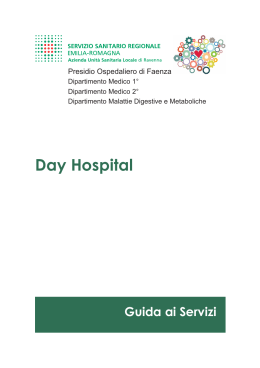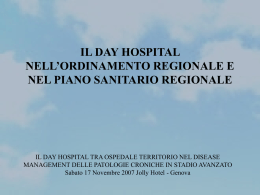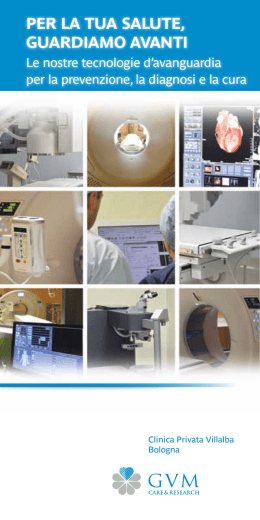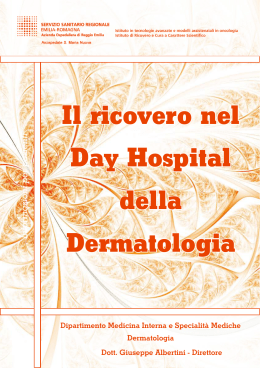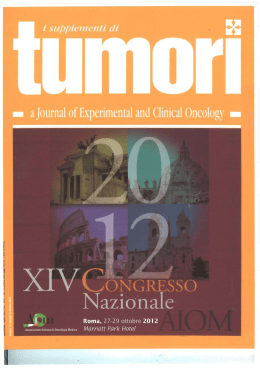IES 2011, Firenze, 30 maggio 2011 Performance measurements for healthcare services Giorgio Vittadini, Vittadini Paolo Berta Università degli Studi di Milano ‐ g Bicocca Viale dell’Innovazione, 10 Building U9, 2nd floor I‐20126 Milan, Italy 1 Tel: (+39) 02 6448 2180 ( ) Fax: (+39) 02 6448 2182 e‐mail: crisp@crisp‐org.it web: www.crisp‐org.it INDEX A. QUALITY CONTROL IN LOMBARDY HEALTH SYSTEM B. EFFECTIVENESS EX POST EVALUATION C CRITICISM TO METHODS OF RISK ADJUSTMENT C. CRITICISM TO METHODS OF RISK ADJUSTMENT D. EFFECTIVENESS RESULTS E. SET OF INDICATORS FOR AN OVERALL ASSESSMENT FOR DEPARTMENTS Crisp project Scientific cooperation with: Sabina Nuti (Scuola Superiore Sant’Anna Pisa) Carlo Perucci ( Agenas) Carlo Perucci ( Agenas) Università degli Studi di Milano ‐ g Bicocca Viale dell’Innovazione, 10 Building U9, 2nd floor I‐20126 Milan, Italy Tel: (+39) 02 6448 2180 ( ) Fax: (+39) 02 6448 2182 e‐mail: crisp@crisp‐org.it web: www.crisp‐org.it A A. QUALITY CONTROL Q IN LOMBARDY HEALTH SYSTEM 1. Lombardy – some data • 9.550.000 inhabitants (16% of Italian population); 9.550.000 inhabitants (16% of Italian population); • 23% of gross domestic product; • 200 hospitals (70% public / 30% private); ( / ) • 2.000.000 of discharges from hospitals; • 60.000.000 drug prescriptions; • More More than 10% of health care services delivered to people than 10% of health care services delivered to people that don’t live in Lombardy; • Around Around 16 billion euro budget for public healthcare 16 billion euro budget for public healthcare (65% of regional total expenditure). 2. Lombardy Health System Principles VALUES Regional Law n. 31 - 11/07/97 Public Regional Service with services supplied by public and private structures. Same rules regarding accreditation and controls about quality and appropriateness. Tariffs established by Regional autority reviewed annually Tariffs established by Regional autority, reviewed annually. Annual Budget for each producer managed by the local health authorities. Purchaser/provider separation and distinction. • Pro capita public health expenditure lower than the national average • Public health expenditure on GDP lower than the national average (5% /6.97%) • Balanced budget Balanced budget • Cost of hospital admission lower than the national average • Case Mix Index higher than the national average Reduction of inpatient admission and increase of day hospital • Reduction of inpatient admission and increase of day hospital 3. Lombardy – Regional information system • Mandatory, standardized, for all suppliers. Mandatory standardized for all suppliers • The information is the base for payment, quality and appropriateness evaluation and regional and local appropriateness evaluation and regional and local plannings. • In In the last fifteen years Lombardy Region invested a large the last fifteen years Lombardy Region invested a large amount of budget for health care quality improvement and evalutation. 4. Quality controls Laws • Regional Law 31/97: regional accreditation process. g / g p • Conformity to ISO 9000 standards. • Resolution 46582 ‐ 26.11.99: financial incentives for healthcare structures that developed quality improvement • Customer Satisfaction Survey (D.G.R VII/8504, 22.3.02). • Legislative Decree n. 8968 ‐ Legislative Decree n 8968 28.5.2004: regional program of quality 28 5 2004: regional program of quality improvement of diagnostic and clinical pathways. • Risk Management activities • (Guidelines for annual Risk Management Activities, 2005). • II edition of “Medical Record Manual” (2007). • Resolution 6682 ‐ 27.2.2008: Indicators and methodology for quality evaluation of hospitals and rehabilitation structures. 5. Noc (Nuclei Operativi di Controllo) They verify the appropriateness of the performance provided by hospital through a method based on a target and a random control hospital through a method based on a target and a random control. Each Local Health Authorities (ASL) controls, and monthly, sends to the Region results that could modify remboursement. . Lombardy 2006 – 2008 Total Discharges 2006 2007 2008 N 2.062.338 1.904.923 1.879.051 Total Controls 2006 2007 2008 N 105.368 109.192 111.595 2006 % Controls 2007 % 2008 5,11 5,73 5,94 2006 Economic Value 2007 € -14.414.309 -21.642.974 -24.958.186 Fonte: Direzione Generale Sanità. Regione Lombardia. Elaborazione: Sezione Regionale del Controllo della Corte dei conti. Total of discharges controlled: from 4,9% of 2004 to 5,9% of 2008 ( (more in private than i i t th in public hospitals). i bli h it l ) 2008: a distorsion in the value of 25% of the files controlled. 8 2008 6. Ex ante evaluation Three years program for the implementation of the evaluation system of accredited healthcare organizations (public and private providers) developed in 2004‐2007 and confirmed for 2008‐2010. The program put togheter different evaluation approaches of Lombardy health care providers: ‐‐ ex ante (es: accreditation criteria, ISO, risk management activity) ‐‐ Quality performance evaluation (set of international standard) The healthcare organizations compliance with standards was evaluated through quarterly self‐evaluation of the organizations and in situ surveys g q y g y carried out by the Joint Commission International team which won an international tender. 9 6. Ex ante evaluation Creation of a set of standards in order to evaluate organizational behaviours Hospitals 58 standards, 5 areas: • Patients rights, clinical care processes • Human resources development • Management of exchange processes of services • Information system f • Quality improvement processes. Local Health Authorities 46 standards, 5 areas: • Protection • Control • Organization • General Practitioner and pediatrician d • Healthcare services Results: High average score, Improvement over time, Positive impact of double assessment (self and Joint Commision team evaluation). Best improvement: patient rights continuity of clinical care process Best improvement: patient rights, continuity of clinical care process. Variability between structures. Most critical aspects: medical chart, quality programs, professional upgrade and criteria of the triage of the triage. 7. Ex post evaluation Customer Satisfaction Efficiency analysis: Economic and productivity performance evaluation Economic and productivity performance evaluation Effectiveness analysis Effectiveness analysis (CRISP project) B. EFFECTIVENESS EX POST EVALUATION 12 1. Ex Post Evaluation: Relative Effectiveness 1. Healthcare outcome: result on the state of patient well‐being, generated by 1 H lth t lt th t t f ti t ll b i t db the delivery of a health service influenced by covariates concerning the “case mix” of the patients, and other characteristics of agents (Goldstein, Spiegelhalter, 1996). 2. With an approach similar to that of Clinical Trials: comparisons between healthcare institutions, Relative effectiveness Relative effectiveness. Need to adjust comparisons for patient‐specific and hospital‐specific variables by means of Risk adjustment statistical methods. i k dj i i l h d 13 2. Risk Adjustment Methodology: Standardization 1) Direct standardization (Zaslavsky 2001) ykj health outcome observed on wkj, k‐eth stratum of the population of patients in the j‐eth health structure h lh πkj = wkj /Σk wkj (k=1,…,q) (1) Ob Observed d adjusted outcome: the weighted sum: dj t d t th i ht d yj = Σk πkj ykj (2) 2) Indirect standardization 2) Indirect standardization Given the expected adjusted outcomes weighted sum yj *= Σkπkj*ykj (3) With the weights are obtained from a standard theoretical population, Problems: 1 1 Stratum with no cases or missing cases Stratum with no cases or missing cases 2 Concerning hospitals no patients, 3 expressed as frequencies 4 based only on outcomes and not on risk‐adjustment variables: y j selection bias and risk of adverse selection 14 3. Risk Adjustment Methodology: Linear and Logistic g Models 1) Covariance Models 1) Covariance Models yij= β xij+uj +eij (5) yij quantitative outcome xij patient characteristic(s) (effects of individual characteristics X on outcomes, among patients of the same unit) β fixed coefficients uj fixed parameter concerning average effectiveness of hospital j eij error term 15 2) Dichotomic outcomes (such as hospital mortality risk) Logistic Function Models (AHRQ,2003; CIHI,2003; NHS,2004; JCAHO, 2004) g ( ) logit of the g outcome pij as a linear function of the case mix variables xk (k=1,…,p): p ij l x1ij 2 x 2ij ... k x kij RS ij ln 1 - p ij which can be exposed in terms of probability: RS ij e p ij RS ij 1 e (6) (7) By estimating the vector β and substituting in (7) we obtain the expected probability p̂ ij compared with observed probability: kj = i p̂ ij i ( p ij ) The (8) kj ratio estimates the effectiveness of the j‐eth health structure (8) 16 4. Hierarchical Data Hospitals Patients 1 1 j n1 When data is hierarchical, with a two stages sample the independence of observations belonging to the same subpopulation does not state It is likely observations belonging to the same subpopulation does not state. It is likely that responses of patients from within the same hospital may be correlated, even after adjusting for the effects of age, gender, severity of illness and risk of mortality since they tend to share certain common characteristics due to of mortality since they tend to share certain common characteristics due to the hospital background (organizational policies, medical culture, clinical guidlines, etc.). . 17 yij = 0+ Σg gj xgij +uj +eij Three risks (Hox 1995 Goldstein, 1995): Three risks (Hox, 1995 ‐ Goldstein 1995) a) If correlation among variables concerning patients belonging to the same hospital grows sub estimation of standard errors of parameters bj and their significativity grows. b) ECOLOGICAL FALLACY (Robinson, 1950) Variables defined at hospital level. Estimation of parameters concerning patients. c) ATOMISTIC FALLACY Variables defined at patient level, (no hospital level). Estimation of parameters concerning hospitals ( Logistic case) Estimation of parameters concerning hospitals ( Logistic case). Hierarchical models, particularly Multilevel Models: Multilevel Models: relationships between outcomes (mortality, health, quality of life) and contextual variables complex hierarchical structures, both individual and p , aggregate levels of analysis: covariance multilevel mixed model (Thomas et al., 1994; Normand et al., 1995; Morris, Christiansen, 1996; Goldstein, Spiegelhalter, 1996; Rice, Leyland, 1996; Leyland, Boddy, 1998; Marshall Spiegelhalter 2001; Dubois et al 1987; Jencks et al 1988; Epstein Marshall, Spiegelhalter, 2001; Dubois et al., 1987; Jencks et al., 1988; Epstein, 1995; Schneider, Epstein, 1996); Hox, (1995); Rodriguez, Goldman, (1995); Goldstein, (1995); Goldstein, Rasbash, (1996); Snejider , Bosker, (1999); Guo, ( ) ( ) j ( ) Zao, (2000); Leyland Goldstein, (2001); Cohen et al., (2003); Hope, Shannon, (2005); Gelman, Hill, (2007). 19 5. Multilevel Modeling yij = 0+ Σg gj xgij +uj +eij where: yij is the outcome regarding the i‐th patient (i=1,…,nj;N=n1++nj+…+nQ) hospitalised in the j‐th hospital (j = 1,…,Q), 0 is the intercept, gjj is a fixed coefficient associated with patient is a fixed coefficient associated with patient‐specific specific covariate x covariate xgijij (g=1,…,G), uj is a random residual associated with the j‐th hospital and indicates its ‘relative its relative effectiveness effectiveness’ adjusted for patient adjusted for patient‐specific specific and hospital‐specific characteristics. eij is a random disturbance associated with the i‐th patient in the j‐th hospital E(eij)=0 ; Var(eij)=σ2; Cov(e1j , e2j) = 0 Hospital Ranking by Multilevel Modeling Hospitals with effectiveness greater than the average Confidence interval uˆ z1 / 2 uˆ Estimate of effectiveness u Hospitals with effectiveness smaller than the average League table from “hospitals comparisons” Resolved problems 1)“fallacy” problems 2) Different amounts of patients in hospitals: Shrinkage factor Diff f i i h i l Sh i k f 3) Randomized rankings ( by means of interval confidence) Prior proposal ( Goldstein Spiegelhalter 1996) a) One outcome b)) Binomial distribution of outcome;; multinormal distribution of uj c) Static model d) No hospital‐specific covariates. Possible generalisations: a) Simultaneous dependency of covariance from multiple outcomes b) Bayesan approach: non binomial (normal) distribution of outcome and ) y pp ( ) multinormal for random parameters of effectiveness c) Longitudinal hierarchical models: dynamic panel data models d) Hospital covariates Only patient covariates: general effectiveness 2 level d) Hospital covariates. Only patient covariates: general effectiveness 2 level covariates: effectiveness net to resources 22 C. CRITICISM TO METHODS OF RISK ADJUSTMENT Mant e Hicks M Hi k 1996; 1996 Lilford et al. 2004; Lilford Pronovost 2010. 2010 23 1. Criticism to rankings / a The use of rankings of hospitals based on random residuals of Multilevel Models has been strongly criticised Multilevel Models has been strongly criticised a) Criticism to a) Criticism to benchmarking health structures benchmarking health structures “The sensitivity of an institution’s position in league tables to the method of risk adjustment used suggests that comparisons of outcomes are unlikely to tell us about the quality of care dissemination of a database for best practice” (Lilford about the quality of care dissemination of a database for best practice” (Lilford Spiegelhalter, 2004). Risk adjustment methods do not show the unexplained difference in mortality rate ( (Jencks,1994). ) b) Variability of effectiveness within hospitals width of confidence intervals) can be very large. This may be due to the heterogeneity of patients within‐hospitalss: the comparison between hospitals is very difficult because the ranking not robust. 24 1. Criticism to rankings / b c) Little samples and particular diseases: a sort of biomedical and clinical studies utilized for evaluation goals of big hospitals and patients population. d) Doubts on death rate as health outcome “The relationship of death rates to quality of care remains controversial ( (Iezzoni et al., 1996). Use of intrahospital mortality. ) e) Criticism to a violent utilizazion of ranking for league tables. ) g g f) Comparison of multilevel model based on observational and epidemiological data. id i l i l d t 2. Answers a. Risk adjustment for drg or for groups of drg concerning single ward b. Evaluation of within and between variance by means of confidence intervals of random parameters: non league tables but division in 3 categories on the basis of their percentile distribution. c. Administrative data Ad i i t ti d t The agencies Th i should h ld facilitate the development f ilit t th d l t and d dissemination of a (computerized) data base for best practice and improvement based on the results for primary and secondary research (Damberg et al.,2003, Rand Manual) 35 d. Outcomes a) Clinical outcomes and risk adjustment Quality of treatment in pathological conditions. Problems: identification of patients, standard format in handwritten medical records, cost and time in the abstraction process, lack of information. d ti i th b t ti l k fi f ti b) Proxy of clinical outcomes and risk adjustment, i.e. Sentinel event Problems: Same problems of clinical outcomes. p c) Quality of life (SF‐36; FIM) General condition of health collected by means of survey data. P bl Problems: Cost; Cross sectional studies; Bias. C t C ti l t di Bi d) Context outcomes From administrative data. Problems: Only necessary conditions for effectiveness; no accuracy of diagnostic process; Differences of diagnostic codes but useful with big populations. Relationships with 30 days deaths, relations between risk adjustment covariates and outcomes 27 HDC outcomes Voluntary Discharges Discharge patient to another hospital Readmission to operating room Readmission to operating room Readmission Overall mortality (intrahospital mortality + 30 days mortality) HDC: risk adjustment patients covariates HDC: risk adjustment hospitals covariates 30 days mortality rate linkage between Hdo e Istat mortality register quality data index N li k d admissions Non linked d i i /T t l d i i / Total admissions * 100 * 100 HDC 2004 linkage 94% HDC 2008 linkage 97% 5 non ranking and league table but information to improve quality for hospitals and practioners 31 e. Rankings Instead of ranking and general league tables information for self improvement information for self improvement on the basis on the basis of relative relative position of hospital in regional situation (under average, average, over average) of average) of different outcomes. f. Potential f. Potential outcomes The goal is The goal is not to verify the utility of the utility of a a method or of a drug respect to the case of non its utilization but a comparison of hospitals in order to verify their RELATIVE position respect other hospitals. D. EFFECTIVENESS RESULTS 33 1. General results Confidence intervals u random paramters uˆ z 1 / 2 uˆ Left less effectiveness right more effectiveness If the interpolant slope is bigger hospital effectiveness is more different General remarks Fixed effects: More significative variables: age, case mix, urgency. Diagnostic of rationality of the model. Random effectiveness effect: 1) The slope of the interpolant decreases: reduction of effectiveness The slope of the interpolant decreases: reduction of effectiveness differences. 2) homogeneity of hospitals with different ownership. 3) monospecialistic hospitals are better than general. Fi l l First level covariates model i d l Less effectiveness: little, non specialized hospitals. 35 3. The DRG’s effectiveness hospital analysis • It consists on the analysis of hospital effectiveness with respect to all It consists on the analysis of hospital effectiveness with respect to all the DRGs provided in Lombardy Region. • It allows to identify the critical aspects of the hospital activity. • It is a strategic tool for the health management to use alongside the other performance indicators in working to do things better. • X variables at the Patient level, Z variables at the Hospital level and K variables at the DRG level. 36 Methodological problem due to data structure In the present analysis the data have not a perfect hierarchical structure It’s important to consider this aspect during the model selection Hospital Patient 1 1 j n1 1 DRG_PzN 1 y j ij , xij I zi i O t t Output DRG_Pz 1 Shared Input ni 1 j nI Not shared Input DRG_Pz 1 DRG_Pz N1 • The DRG level could not be considered a genuine level, instead in the present study it is defined as being a Pseudo‐Level present study it is defined as being a Pseudo Level (Levin, Leyland 2005 (Levin, Leyland 2005 – Stweart 2010). • The pseudo‐level is a specific characteristic of the data (at the patient level) f for which we want to control the variability. hi h tt t l th i bilit • One of the difficulty is to adapt the setting of the multilevel software to p allow for the pseudo level. Yijk = α000 + ΣgβgXgijk + γjDRGj + v0jk +u00k+eijk i= 1, …, n Patients - j = 1, ….J DRGs - k = 1, … , K Hospitals • 38 γj is i a fi fixed d coefficient ffi i t associated i t d with ith DRG DRG-specific ifi d dummy variable i bl • v0jk is a random residual associated with the j-th DRG and k-th hospital • u00k is a random residual associated with the k-th hospital Exclusion criteria: The DRGs provided less then 30 times and in less then 3 hospitals in the year. The DRGs for which The DRGs for which mortality is not observed. observed Results: The model results provided to managers are divided in 3 categories on the basis of their percentile distribution and are given the following symbols: + – and = following symbols: +, and = 39 ‐ One symbol identify the internal comparison (Fixed the hospital we compare the performance between different p p p DRGs) ‐ One symbol identify the external comparison (Fixed the DRG we compare the performance between different Hospitals)) Comparison between different j‐DRGs provided in same hospital p j p p (v0jk with fixed k‐th hospital) 40 The second way to compare the DRG performance is the following Yijk = α0j0 + ΣgβgXgijk + γjDRGj + v0jk +eijk i= 1, …, n Patients - j = 1, ….J DRGs - k = 1, … , K Hospitals • 41 γj is a fixed coefficient associated with DRG-specific dummy variable • α0j0 is a random intercept associated with the j-th DRG • v0jk is a random residual associated with the j-th DRG and k-th hospital p Comparison between the same DRG provided in different k‐ hospitals (v0jk with j‐th DRG fixed) 42 43 DRG DESCRIZIONE PUNTEGGI 012 Malattie degenerative del sist. nervoso == 014 Malattie cerebrovascolari specifiche escl. TIA ‐‐ 088 Malattia polmonare cronico‐ostruttiva += 090 Polmonite semplice e pleurite, eta' >17 senza CC ‐‐ 104 Interventi su valvole card. e altri interv. maggiori cardiotoracici con cateterismo card. =‐ 105 I t Interventi su valvole card. e altri interv. maggiori cardiotoracici senza cateterismo card. ti l l d lt i i t i i di t i i t t i d ‐‐ 110 Interventi maggiori su sist. cardiovascolare con CC ‐= 116 Impianto PM cardiaco permanente con altre patologie ‐‐ 131 Mal. vascolari periferiche senza CC ++ 138 Aritmia e alterazioni conduzione cardiaca con CC ‐‐ 139 Aritmia e alterazioni conduzione cardiaca senza CC == 142 Sincope e collasso senza CC += 148 Interventi maggiori su intestino crasso e tenue con CC gg ‐‐ 174 Emorragia gastrointestinale con CC ‐‐ 294 Diabete, eta' >35 =+ 297 Disturbi nutrizione e metabolismo, eta' >17senza CC = 323 Calcolosi urinaria con CC e/o litotripsia ESW Calcolosi urinaria con CC e/o litotripsia ESW ‐‐ 395 Anomalie globuli rossi, eta' >17 == 410 Chemioterapia senza dia. secondaria di leucemia acuta =‐ 478 Altri interventi vascolari con CC ‐‐ 483 h i l di bi li l i i f i i Tracheostomia escl. per disturbi orali, laringei o faringei =+ 516 Interventi su sist. cardiovascolare per via percutanea con IMA == 4.Effectiveness Analysis Multilevel Model Ward – Patient: one model for each outcome and each ward (50). Surgery Medicine C di l Cardiology Cardiac surgery Neurology Neurosurgery Voluntary Discharges Vol ntar Discharges Discharge patient to another hospital Readmission to operating room Readmission to operating room Readmission Overall mortality (intrahospital Overall mortality (intrahospital mortality + 30 days mortality) Urology Gynecology Oncology Ortopedics A l d Departments Analysed D E l Evaluated d Outcome O Multilevel Model Ward – Patient: one model for each outcome and each ward (50). N° ° Operating Rooms Sex N° Wards Type of Emergency Department Type of Emergency Department Age Average Age of the Ward Admission in Emergency Average Length of Stay of the Ward g g y Cardiological discharge g g % Emergency Admission for Ward Oncological discharge % Oncolgical Discharges for Ward Comorbidity (Elixhauser Index) % Cardiological Discharges for Ward Stay in Intensive Care Unit (ICU) Average Ward Comorbidity (Elixhauser Index) (Elixhauser Index) Rembourment for the discharge Department Level Variables p Length of Stay Length of Stay Patient Level Variables Multilevel Model Ward – Patient: 1 model for each outcome and each ward (50). Confidence Interval Analysis: Confidence Interval Analysis: Setting Setting a score according to the significance of the odds ratio: a score according to the significance of the odds ratio: • Hospitals in the green area = 3 • Hospitals in the red area = 1 • Hospitals in the middle of signifiance= 2. Hospitals in the middle of signifiance= 2 46 E. SET OF INDICATORS FOR AN OVERALL ASSESSMENT FOR DEPARTMENTS 47 1. Development of evaluation system (CRISP project) Summary hospital activity: 10 d 10 departments analysed and evaluated in the following dimensions l d d l d i h f ll i di i ‐ Effectiveness ‐ Appropriateness ‐ Standard Evaluation ‐ Efficiency ‐ Access ‐Scores from 1 to 3 according to quality level: 3 it’s a good performance and 1 it’s a bad performance. Departments 48 ‐ Surgery ‐ Cardiology ‐ Neurology ‐ Urology U l ‐ Oncology ‐ Medicine ‐ Cardiac surgery ‐ Neurosurgery ‐ Gynecology G l ‐ Ortopedics 2. Analysis of Hospital Appropriateness Surgery Medicine Cardiology Cardiac surgery Neurology N Neurosurgery Cream Skimming Upcoding Riadmission in 30 days for the same MDC Local Health Authorities Control ((NOC)) Urology Gynecology Oncology Ortopedics Analysed Departments Analysed Departments Dimensions Cream Skimming: C Ski i • DRG Provided (net of exclusion criteria) Upcoding: • Rate of Complicated DRG for departments related to the pairs of DRG Complicated/Not Complicated • Rate between Departement index and Regional Index • Standadised by Comorbidity Index Riadmission in 30 days for the same MDC Health Care Authorities Control: • Average Positive Control 50 3. Analisys of Hospial Efficiency and Standard Evaluation Tecnical Efficiency: y • Analysis for hospital. • Obtained through the Stocastic Frontier Standard St d d Evaluation: E l ti • Analysis for hospital. • Average score for area of the Joint Commission indicator related to Average score for area of the Joint Commission indicator related to the Patient Safety. 4. Access Analysis Customer satisfaction analysis: • Considering 2 questions from the Lombardy customer satisfaction survey: C id i 2 ti f th L b d t ti f ti the first question is related to the satisfaction for the medical activity. The second one is related to the satisfaction for the nursey service. • Analysis for hospital. Waiting List analysis: • Analysis for hospital. Analysis for hospital • Average waiting list considering regional goals for each procedures. 5a. Radar chart for hospital results: 53 5b. Radar chart for hospital results 54 a.1 Small Hospital 55 a.2 Small Hospital 56 b.1 Big Hospital 57 b.2 Big Hospital 58 c.1 Specialized Hospital 59 c.2 Specialized Hospital 60 REFERENCES F. Moscone, E. Tosetti, G. Vittadini (2011), Social Interaction in Patients’ Hospital Choice: Evidence from Italy, accepted for publication in the Journal of the Royal Statistical Society Series A (Statistics in Society). P.G. Lovaglio, G. Vittadini (2011), The Balanced Scorecard in Health Care: a Multilevel Latent Variable approach, accepted for publication in the Journal of Modelling in Management. P.G. Lovaglio, G. Vittadini (2010), Balanced Scorecard Health System: a latent variable approach, Statistica Applicata, vol. 3‐4/2008, pp.273‐292. P. Berta, G. Callea, G. Martini, G. Vittadini (2010), The Effects of Upcoding, Cream Skimming and Readmissions on the Italian Hospitals Efficiency Modelling: a Population‐based Investigation, Economic Modelling, Volume 27, Issue 4, Pages 789‐890, July 2010, ISSN 0264‐9993,. N. Solaro, G. Vittadini (2009), Assessing individual treatment effectiveness in the presence of structurally missing measurement occasions, Statistica Applicata, 21, 2, 1‐30. E. Monzani, A. Erlicher, A. Lora, P.G. Lovaglio, G. Vittadini (2008), Does community care work? A model to evaluate the effectiveness of mental healthservices , International Journal of Mental Health Systems 2008, 2:10 , G. Vittadini (2006), Ex‐post Evaluation and Relative Effectiveness of Health Structures: an Overview,in Toward d ( ) l d l ff f lh d Quality of Life Improvement, Proceedings of the Third International Conference, Wroclaw University of Economics, pp.132‐151 G Vitt di i S C Mi tti (2005) A th d l f i th l ti ff ti f h lth i G. Vittadini, S. C. Minotti (2005), A methodology for measuring the relative effectiveness of health services, IMA Journal of Management Mathematics (Special Healthcare Issue), 16(3), pp. 239‐254 61 REFERENCES G. Vittadini, M. Sanarico, C. Rossi (2003), Recenti sviluppi nella metodologia statistica per la valutazione dell’efficacia degli ospedali, in Statistica, LXIII, n. 1. G Vitt di i M S G. Vittadini, M. Sanarico (2002), Metodologia per lo studio dell’efficacia relativa di strutture sanitarie, i (2002) M t d l i l t di d ll’ ffi i l ti di t tt it i in Statistica Applicata, Vol. 14, n. 3 G. Vittadini, P. Berta (2010), La valutazione dell’efficacia in sanità, in La valutazione della qualità nel sistema sanitario, Analisi dell’efficacia ospedaliera in Lombardia, Edizioni Guerini e Associati, Milano, pp. 25‐64, ISBN 978‐88‐6250‐305‐ 1. L. Merlino, G. Vittadini (2008), Perché è necessario misurare le performance?, in Il Welfare in Europa: la domanda di salute, Rapporto Cefass 2008, CEFASS‐EIPA, Milano, pp. 295‐318. L Merlino C Rossi G Vittadini (2008) Metodi di valutazione della qualità in sanità: uno sguardo internazionale in Il L. Merlino, C. Rossi, G. Vittadini (2008), Metodi di valutazione della qualità in sanità: uno sguardo internazionale, in Il Welfare in Europa: la domanda di salute, Rapporto Cefass 2008, CEFASS‐EIPA, Milano, pp. 319‐341. G. Vittadini, S.C. Minotti (2006), Valutazione di efficacia e di efficienza: uno sguardo d’insieme, in Valutare la qualità, i servizi di pubblica utilità alla persona, a cura di M. Carpita, L. D’Ambra, M. Vichi e G. Vittadini, Edizioni Guerini e Associati, Milano, pp. 203‐243. G. Vittadini, R. Carabalona, C. Rossi (2004), Metodologie statistiche di valutazione dell’efficacia delle strutture sanitarie, in Qualità e valutazione delle strutture sanitarie, a cura di A. Pagano, G. Vittadini , Etas, Milano, pp. 269‐282. , , ( ), g p g p G. Vittadini, R. Carabalona, C. Rossi (2004), Sistemi di indicatori e di benchmarking della performance degli ospedali: uno sguardo d’insieme, in Qualità e valutazione delle strutture sanitarie, a cura di A. Pagano, G. Vittadini, Etas, Milano, pp. 93‐114 G. Vittadini, M. Sanarico, C. Rossi (2003), Recenti sviluppi nella metodologia statistica per la valutazione dell’efficacia degli ospedali in Statistica LXIII n 1 ospedali, in Statistica, LXIII, n. 1. ∙ G. Vittadini, M. Sanarico (2002), Metodologia per lo studio dell’efficacia relativa di strutture sanitarie, in Statistica Applicata, Vol. 14, n. 3 62 Contact us CRISP – University of Milano Bicocca Viale dell’Innovazione 10 (Building U9) I‐20126 Milan, Italy Web: www.crisp‐org.it E‐mail: crisp@crisp‐org.it Tel: Fax: (+39) 02 6448 2180 ((+39) 02 6448 2182 39) 02 6448 2182 63
Scarica


